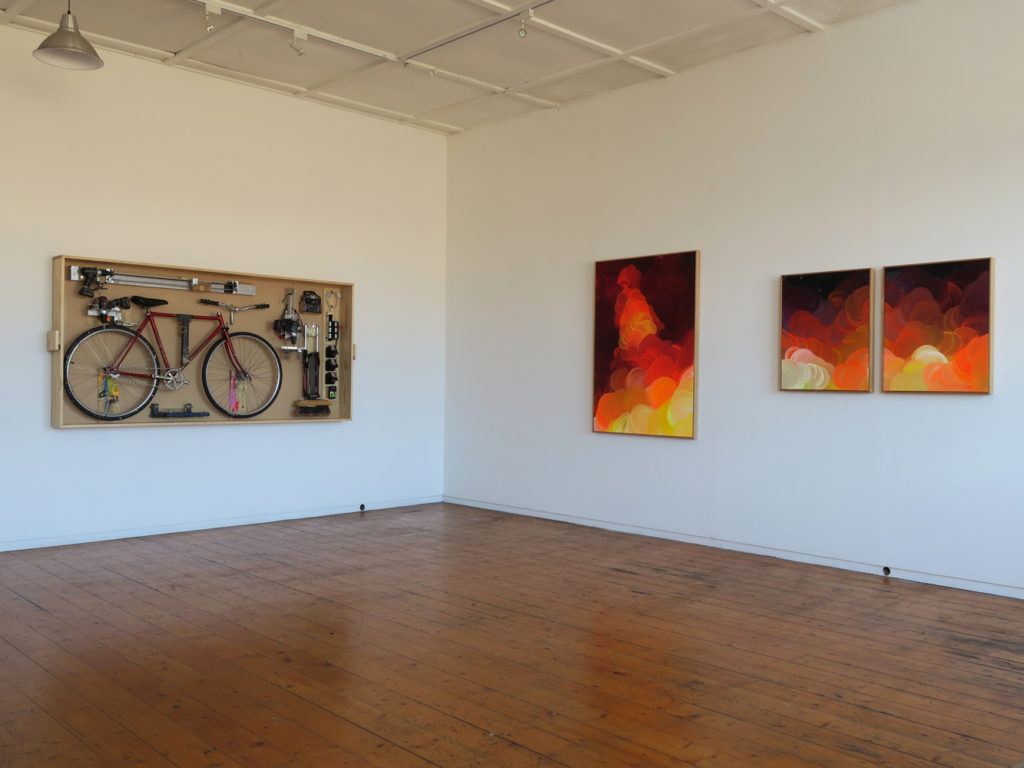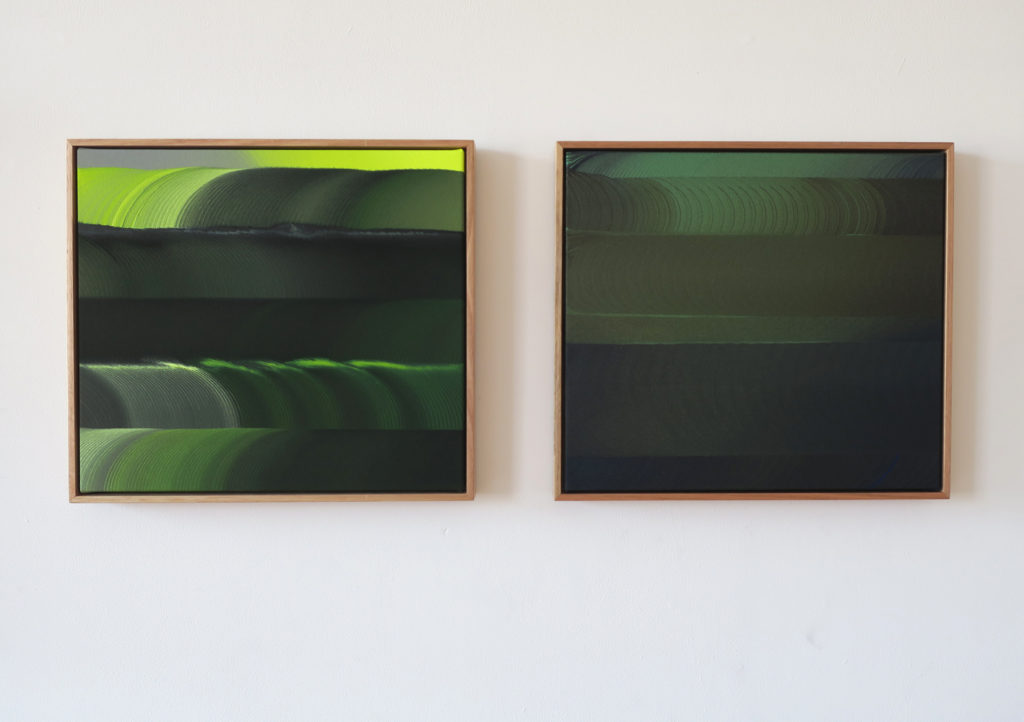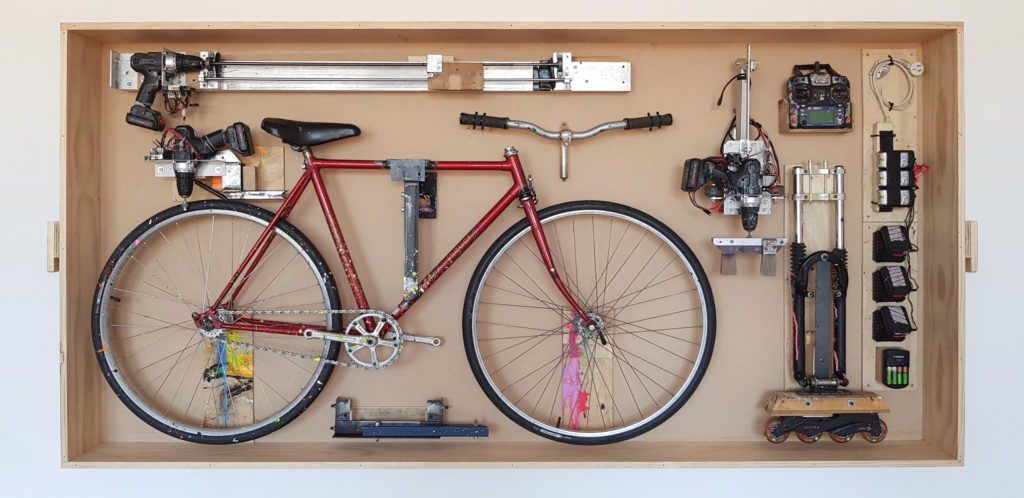Presented by Hanging Valley, Melbourne
December 2018
ADAPTER
BEN ELTHAM
———–
James Dodd
Adapter
I first became a confirmed fan of James Dodd’s work on seeing his word art diptych, Auto-Erotic Suicide, at my friend David Campbell’s house.
There is something slashing and unconventional about the piece, which I reckon both embodies and subverts one of art’s most hidebound and conventional genres. It’s from Dodd’s early phase, best seen at the Speakeasy and Cryptophilistinism shows of the 2000s. There’s an insistent energy about those earlier works that draws from street art vernaculars, but moves them sideways into a liminal, hallucinogenic space. Like a lot of James Dodd’s work, it’s playful and punk and kind of exciting.
There’s a similar jerry-rigged punk aesthetic at play in some of Dodd’s later work, which now focuses, I think we have to admit, on the production of ready-mades. While the form might have changed, there is still a recognisable energy and chutzpah to these later pieces. They ask questions. They jest. They provoke.
You can see it in chromatic resplendence in his recent show Miller, with its pleasing self-references to the colour palettes of Dodd’s younger period. Such confident and unabashed abstraction is both grandly cerebral and satisfyingly kinetic. Leigh Robb, in a recent essay, justly proposes the Painting Mill project as performing a kind of Aussie Minimalism, drawing on influences that seem equal parts Donald Judd and Steele Rudd. And you can certainly see that here in Adapter.
What you couldn’t easily guess is that such work is fashioned by the craft of a Heath Robinson contraption, a bewildering engine, seemingly ‘Macguyvered’ from common household components. But so it is. The Painting Mill, as Dodd calls it, is by any apprehension an ingenious device, lashing together second-hand joysticks and electric drills, bicycle parts and rollerblades.
On hearing Dodd describe the Painting Mill, I was reminded of Katherine Wilson’s marvellous recent book, Tinkering. A shrewd observer and a quick wit, Wilson spent years hanging out with such tinkerers: men and women in sheds, largely. “United only by their values and habits,” she explains, they are people who like to fiddle with things, for fiddling’s sake.
Wilson tells us that:
“Everyday tinkerers are very often individuals and collectives of people who work at home according to artisanal and amateur values: agency, freedom, risk, experimentation, originality, learning, play and autonomy. Within a culture of precarious social and labour conditions, these people manage to tend to their sources of wholeness.” (p.4)
What can we learn from all this? An awful lot, as it turns out. The modern DIY movement, now often referred to as DIO (“do it ourselves”), is a loose zeitgeist of making and re-making. “Committed tinkerers have much to teach all of us about negotiating power amid living well, especially amid current conditions,” Wilson writes. There is something old-worldly and admirable about this insistence on twiddling and fixing, making and mending, doing and doing over.
No doubt many would have been sceptical when first beholding James Watt’s steam condenser. And yet the utility of the infernal kettle was immediately apparent to practical men of the calibre of Matthew Boulton. But, you might ask, what art-making machine has ever changed the world? Perhaps you will reflect on the absurdity of such an idea later tonight, as you recline with your computer watching Netflix. Maybe we will one day see the Painting Mill in such a way.
It’s no coincidence that Wilson devotes some serious attention to the tinkerers Chris Block and Mark Thomson, whose various oddities and rarities include works like the Random Excuse Generator and the Toroidal Vortex Smoke Ring Generator. On seeing the smoke ring generator, you might well ask, ‘is this is a joke?’ Well … yes. There is something funny about these contraptions. And I do think there’s something funny about the Painting Mill as a device.
It’s worth remembering that E.F. Schumacher originally called for “interim technologies”, a more useful definition than the “appropriate technology” more commonly employed today. Dodd’s Painting Mill is simultaneously a technik and a technique. As Robb suggests, we should celebrate it as much for its ingenuity as for its imagery, a DIY rebellion, “armed with a loyalty card from Bunnings.”
The history of art is, among other things, the history of art machines, from the camera obscura to the oculus rift. In this longue durée, Duchamp and Jean Tinguely were far less innovative than they are sometimes made out to be. As the science and technology scholars like Bruno Latour and John Law remind us, machines and humans have been working together a very long time.
The hand, and the handicrafts we construct with it, form networks of actors. We have fashioned constructs, both literal and figurative, that make things in the world. But what the Painting Mill produces is important too: images of subtle depth and no little beauty. After all, Heath Robinson was very funny, but perhaps his most poignant work was the subtle and sad cartoons he devoted to war.
References
Katherine Wilson (2017) Tinkering: Australians reinvent DIY culture, Clayton: Monash University Publishing.
Leigh Robb (2017) ‘James Dodd: Cycles of invention’, Shed Wizard, Country Arts SA touring exhibition, pp. 7-15.
Heath Robinson Museum (2017) Heath Robinson at War, Pinner, UK: Heath Robinson Museum, accessed at https://www.heathrobinsonmuseum.org/exhibition/590 accessed 21 November 2018.





